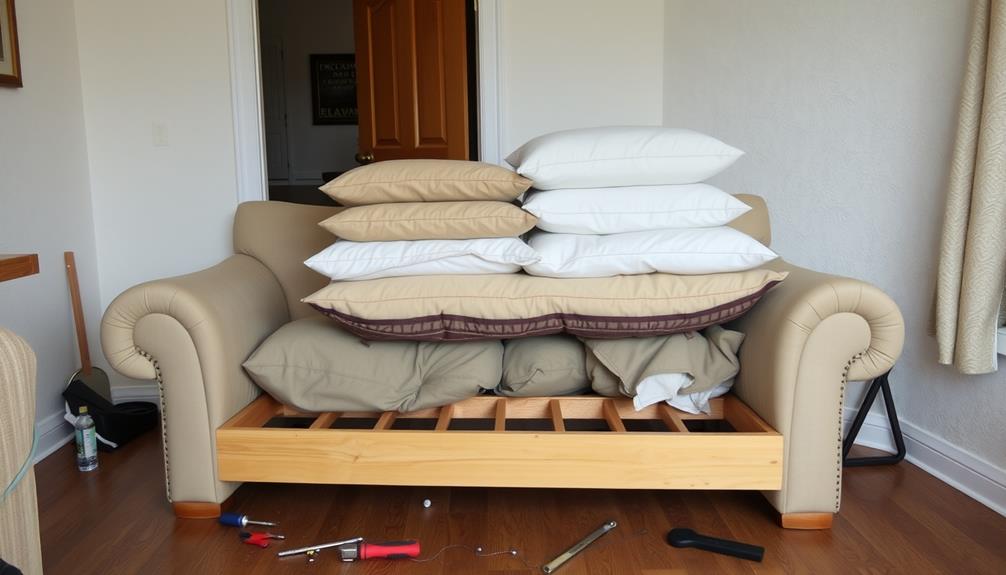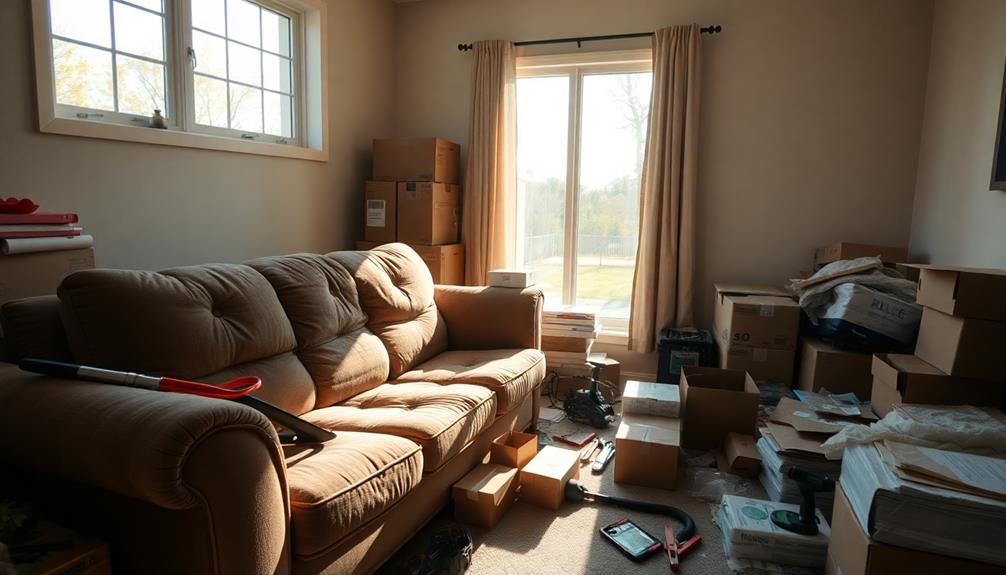In order to get a sofa through a door, you’ll need to have the necessary tools such as a screwdriver, pliers, and a staple remover. Begin by taking off the cushions, then proceed to unscrew the legs to reduce the height. If possible, remove the arms and back to make it easier to move. Take photos of each step to help with putting it back together. Be cautious of sharp edges and wear safety equipment for protection. Plan out your path and ask a friend for assistance with the heavier sections. This method will simplify the process of moving your sofa, and there are more tips available to make it even easier. When it comes to reupholstering your sofa, choosing the appropriate fabric is essential. Think about the fabric’s durability, color, and texture to ensure it matches your style and can withstand daily use. Take your time making this decision, as the fabric you select will have a significant impact on the sofa’s appearance and lifespan.
Key Takeaways
- Measure both the sofa and doorframe to determine if disassembly is necessary for a proper fit.
- Remove detachable components like cushions, legs, and arms to reduce the sofa's size.
- Use essential tools, including a screwdriver and staple puller, for efficient disassembly.
- Document each step with photos to simplify reassembly once moved through the door.
- Enlist a friend for assistance to safely navigate heavy and bulky parts during the move.
Professional Help vs. DIY Approach
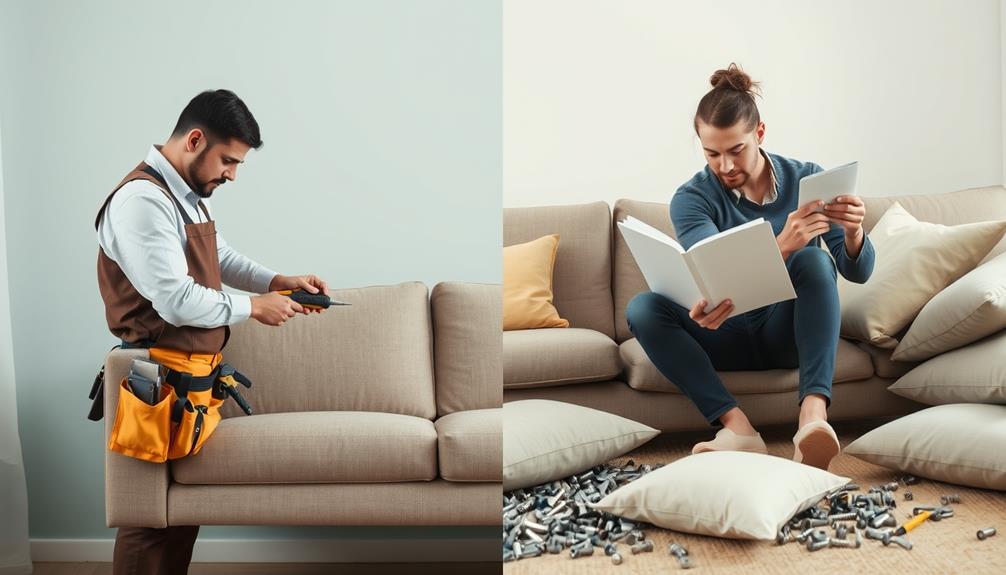
When it comes to disassembling a sofa, you've got two main options: hiring a professional or tackling it yourself. If you opt for professional help, services like NY Couch Doctor can charge between $250 and $400 per piece. If you've got multiple sofas, those costs can skyrocket to over $1000 with added travel fees.
For those who prefer a more hands-on approach, utilizing the right tools and techniques can make a world of difference in the process; best vacuums for dust removal can help keep your space clean while you work. That said, if you're confident in your skills, a DIY approach can be a more budget-friendly alternative.
With the DIY method, you can save a significant amount of money, especially if you have prior upholstery experience. However, it requires careful planning and the right tools to effectively remove various components without causing damage. Expect the disassembly process to take around 12 hours, but using specialized tools, like a staple puller, can help streamline the task.
Community feedback often highlights the rewarding feeling of successfully completing a DIY project, setting the stage for future furniture modifications. Ultimately, whether you choose professional help or the DIY route depends on your skills, budget, and the time you're willing to invest.
Essential Tools and Materials
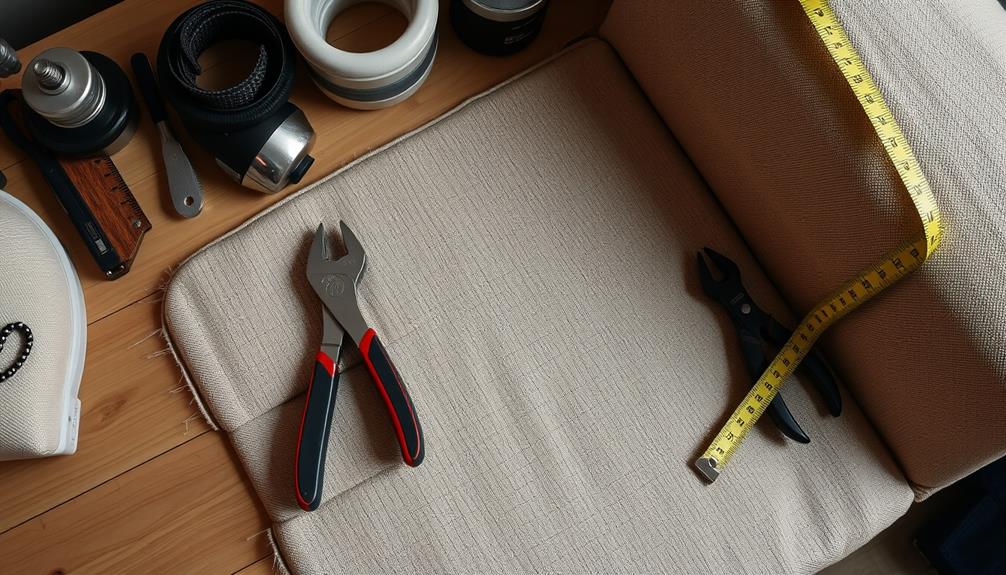
What tools do you need to effectively disassemble a sofa? First, grab a screwdriver; it's essential for removing screws that hold various components together.
You'll also want a pair of pliers to help with gripping and pulling out any stubborn fasteners. It's important to guarantee that you have well-maintained tools, as using high-quality equipment can make the process smoother and more efficient, much like preventive maintenance plans for appliances.
A staple puller is critical, as you'll likely encounter around 200 staples that secure the upholstery and dust cover. For those tougher staples, a staple remover can ease the process, saving you time and effort.
Don't forget a rubber mallet; it's perfect for gently loosening parts without causing damage. A hammer is essential for driving out nails and tacks that may hold the fabric in place.
If you're looking to make clean cuts or adjustments, a circular saw and a power drill can be incredibly handy.
Step-by-Step Disassembly Guide
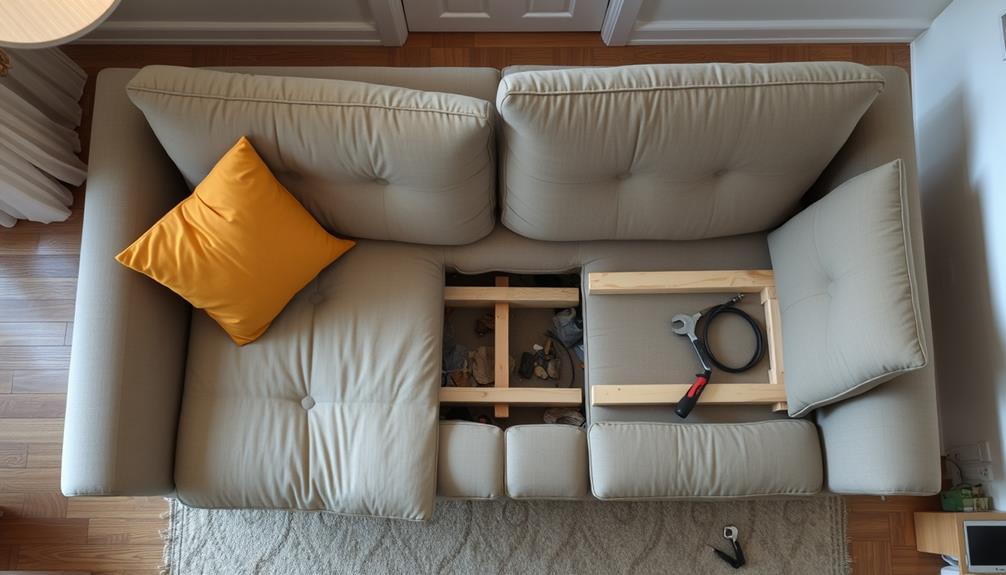
To successfully take apart your sofa, you’ll need a few essential tools like a staple remover and a screwdriver. Additionally, having a pair of pliers and a hammer on hand can make the process smoother and more efficient. For those looking to remove sofa from rv easily, ensure you’ve cleared the area around the sofa to avoid any obstructions. Once you have your tools ready and the space cleared, you’ll be well-prepared to tackle the disassembly with confidence.
Understanding the importance of quality assurance in software development can also be helpful in ensuring that you handle each component with care.
Knowing key disassembly techniques will make the process smoother and more efficient.
Let's walk through each step to get your sofa ready for transport or storage.
Tools Required for Disassembly
Gathering the right tools is essential for taking apart a sofa efficiently and safely. Having everything ready before you start can make the process smoother and prevent any unnecessary damage.
Additionally, understanding the importance of budgeting for home repairs can help you allocate funds for any unexpected expenses that may arise during the process.
Here's a list of the vital tools required for disassembly:
- Flathead screwdriver – You'll need this for prying apart components and removing certain screws.
- Staple puller – This tool is critical for tackling the approximately 200 staples often found in sofa construction, especially from the dust cover and back piece.
- Power drill – A handy tool for quickly removing screws that secure the legs, arms, and back of the sofa.
- Rubber mallet – Use this to detach stubborn components without damaging the sofa frame or upholstery.
Additionally, having pliers and a claw hammer can be helpful.
Don't forget a tarp or drop cloth to contain debris and protect your floors while you work.
With the right tools in hand, you'll be well-prepared to disassemble your sofa and make it fit through that door without a hitch! You can start by gathering the necessary tools such as a screwdriver, pliers, and maybe even a drill if needed. Once you have everything you need, following a sofa building tutorial will give you a step-by-step guide on how to disassemble and reassemble your sofa. With the right guidance, you’ll be able to maneuver your sofa through narrow spaces with ease. Just remember to take your time and follow the instructions carefully to avoid any mishaps during the process.
For those interested in financial health, remember that investing in your home can also contribute to your overall budget planning.
Key Disassembly Techniques
With your tools ready, you can now start the disassembly process.
Begin by removing the seat and back cushions, which are usually detachable. It's helpful to keep your workspace organized, similar to the best practices for cross-contact prevention in kitchens. Pack the cushions in labeled bags to guarantee easy transport and reassembly later.
Next, unscrew or unbolt the legs of the sofa; this will considerably reduce its height and make maneuvering through doorways much easier.
If you need to, carefully remove the upholstery to access the staples securing the arms. Use a staple puller to remove the staples without damaging the fabric.
For larger sofas, unscrew the back from the frame, typically involving about six screws. This step will help decrease the overall size, making it easier to fit through tight spaces.
If you're dealing with a sectional sofa, locate and detach any clasps or snap connectors to separate the sections before moving them.
Don't forget to take photos throughout the process; they'll be invaluable when it's time to reassemble the sofa.
Common Challenges Encountered
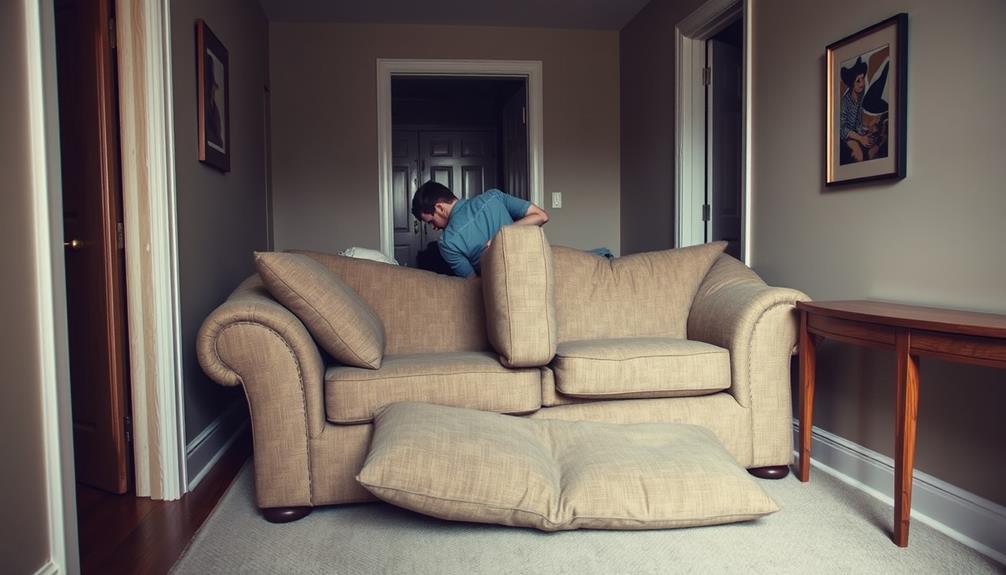
When you start taking apart your sofa, you'll quickly notice that tight doorways and sharp corners can really complicate things.
The weight and bulkiness of the sofa can make it tough to maneuver, putting you at risk for injury if you're not careful.
To help relieve stress during this process, consider incorporating techniques similar to those used in aquatic exercises that promote joint mobility and flexibility.
Be prepared to tackle these challenges head-on to guarantee a smoother disassembly process.
Tight Doorways and Corners
Maneuvering tight doorways and corners can be one of the most challenging aspects of moving a sofa. To make this task easier, you need to focus on a few key strategies. First, you should take careful measurements of both the sofa and the doorways. This helps you identify the best angles for maneuvering.
Additionally, consider enlisting the help of a few friends to guarantee you have enough support during the process, as having extra hands can be invaluable in managing difficult angles and heavy lifting. Knowing about financial considerations for elderly care can also be beneficial, especially if you're helping a loved one shift to a new living situation.
Here's a quick list of tips to help you navigate those tricky spots:
- Disassemble the sofa: Remove the legs, arms, and backs to reduce its size considerably.
- Clear the path: Move any obstacles like door frames or other furniture that might hinder your progress.
- Use protective materials: Wrap the sofa in moving blankets to protect the upholstery as you navigate tight spaces.
- Get help: Don't hesitate to ask friends or family for assistance, as having extra hands can make a big difference.
Weight and Bulkiness Issues
Taking apart a sofa can be a challenging task, especially when you're faced with weight and bulkiness issues. Heavy sofas often make it difficult to navigate tight doorways, and improper lifting techniques can lead to injuries. To avoid this, always lift with your legs and have a friend help.
Additionally, when managing bulky items like sofas, consider the importance of cold medications overview for any potential discomfort you might experience from lifting. You should also assess whether you need to take your sofa apart. If it's particularly bulky, careful planning is essential.
Before you start, measure both your sofa and the doorframe to see if it'll fit through. If you're dealing with a sleeper sofa, be aware that the added weight and complexity might mean more steps for disassembly.
Tight corners and narrow staircases may require you to remove legs, arms, or backs, which can help reduce the overall size and make it easier to transport.
Throughout this process, be careful not to damage any parts of the sofa. Taking the time to disassemble properly not only helps fit your sofa through the door but also protects your furniture from unwanted wear and tear.
Emotional Journey of Disassembly
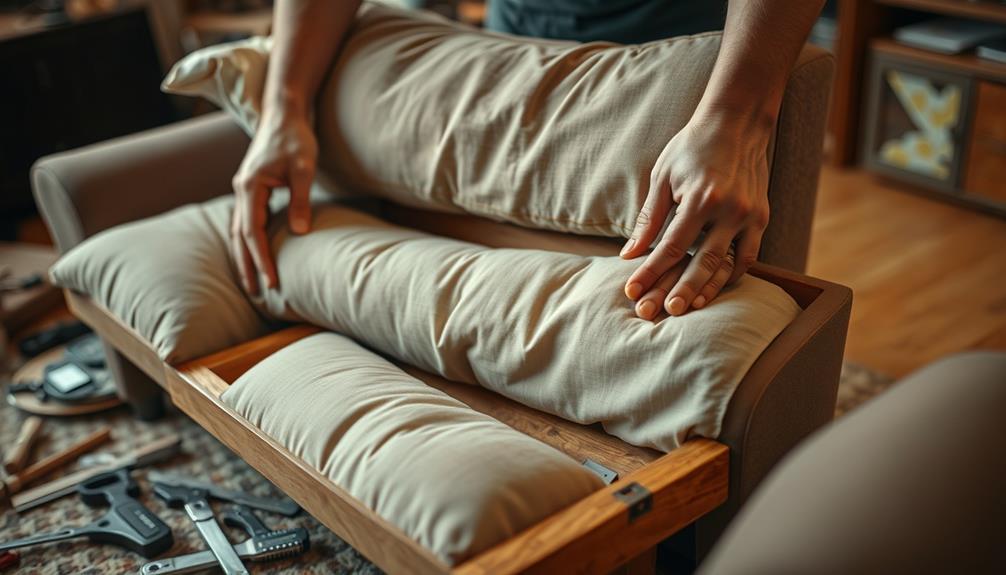
Starting on the journey of disassembling your sofa can stir up a whirlwind of emotions, from initial anxiety to eventual triumph. You might feel overwhelmed thinking about the effort required, but with careful planning, you can turn those nerves into a rewarding experience.
To make the process smoother, consider employing strategies like seeking common ground with your partner or friend to guarantee a collaborative atmosphere. Here's how to navigate your emotional journey:
- Prepare: Organize your tools and designate a space for disassembly. This planning can ease your anxiety and set a positive tone.
- Seek Emotional Support: Invite a friend or partner to assist you. Their presence can transform a challenging task into a fun, collaborative effort.
- Embrace Feelings of Bravery: As you tackle each piece, recognize the courage it takes to face this challenge. Celebrate small victories along the way!
- Enjoy the Sense of Accomplishment: Once you've successfully disassembled the sofa, relish the relief and satisfaction that comes with overcoming obstacles.
Completing this task not only enhances your DIY skills but also builds confidence.
Community Insights and Reactions

As you embrace the journey of disassembling your sofa, you'll find a vibrant community of fellow DIY enthusiasts ready to share their insights and experiences. Many of them have tackled similar challenges and are keen to help you along the way. You'll discover that when your sofa has removable parts, the task becomes much more manageable.
Here's a quick overview of what community members often share:
| Technique | Tool Suggested | Emotional Insight |
|---|---|---|
| Pull out the staples | Staple remover | Relief after a tough battle |
| Use a Sawzall | Sawzall | Bravery in facing challenges |
| Borrow tools | Local library | Satisfaction in community support |
| Remove arms and backs | Screwdriver | Accomplishment from DIY disassembly |
You'll notice that participants frequently express admiration for creative modifications and the sense of accomplishment that follows. Sharing stories about overcoming obstacles like tight hallways fosters a sense of belonging, encouraging you to take on your own disassembly project with confidence. Embrace this community, and you'll find both support and inspiration.
Safety Precautions to Consider
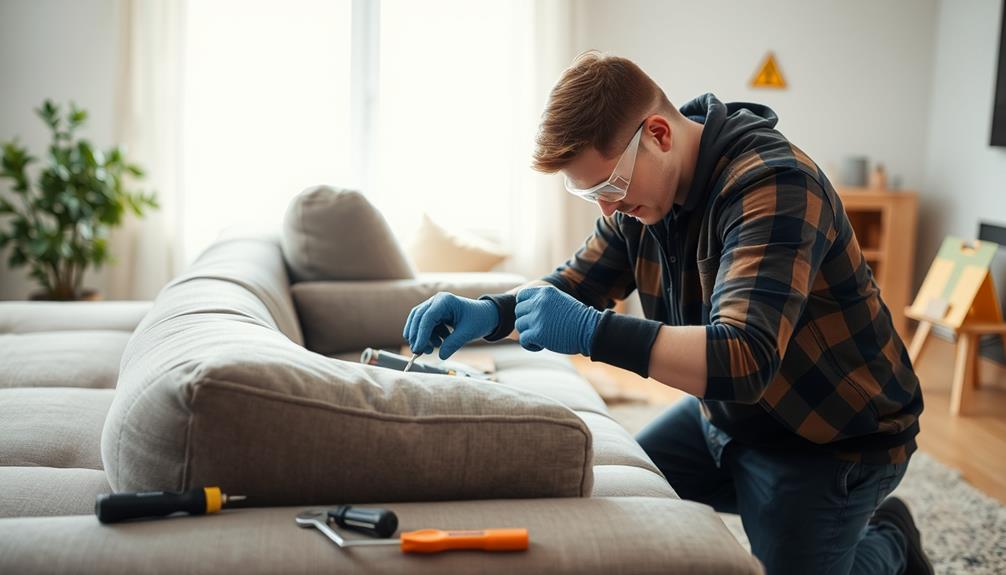
When disassembling your sofa, a few essential safety precautions can make all the difference in guaranteeing a smooth process.
Prioritizing safety helps protect you from injuries and keeps your workspace organized. Here are some key tips to remember:
1. Wear safety goggles: Always protect your eyes when cutting or removing parts. Flying debris can cause serious injuries, so don't skip this step.
Additionally, maintaining a clean environment is vital, similar to how regular cleaning of air purifier filters guarantees peak performance and hygiene.
2. Use gloves: Protect your hands from sharp edges and splinters while handling sofa components. They can be rough, and gloves will help prevent cuts.
3. Clear your workspace: Make sure your area is free from obstacles. A tidy workspace allows for safe movement around the sofa and reduces the risk of tripping.
4. Ventilate the area: If you're using power tools, guarantee proper ventilation. This helps avoid inhaling dust and fumes, especially when cutting materials.
Resources for Further Assistance
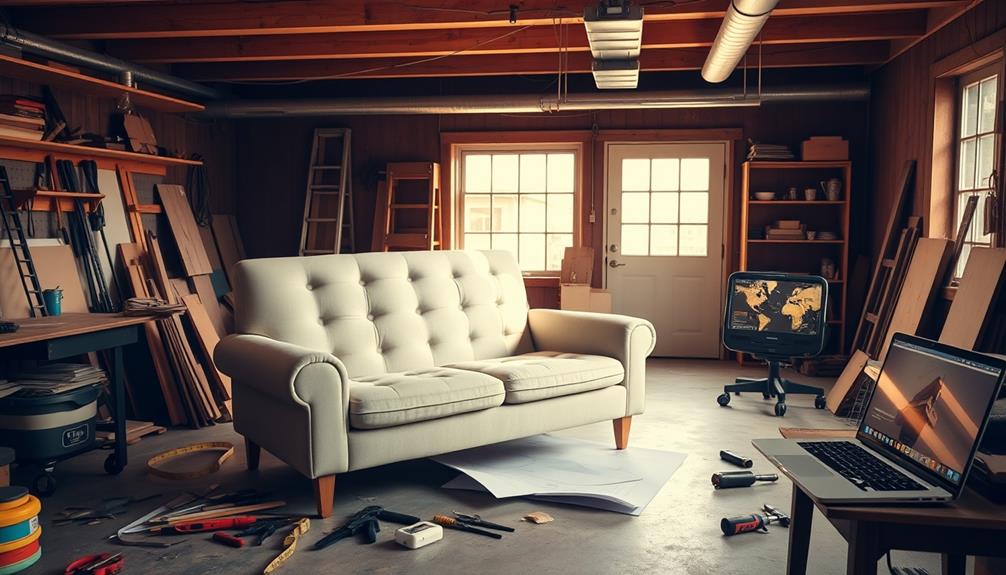
Numerous resources are available to help you disassemble your sofa with confidence. Online platforms like YouTube offer a wealth of video tutorials that guide you through various methods for taking apart your sofa. These visual aids can be invaluable, especially if you're unsure where to start.
If you need tools, consider visiting a local tool library. They often lend out staple pullers and saws without any cost, making your project more affordable.
Community forums like Reddit or Ask MetaFilter are also great places to connect with others who've faced similar challenges; you can share tips and learn from their experiences.
Additionally, websites like Freecycle.org and Craigslist can help you find local services or volunteers ready to assist with furniture disassembly and moving.
If you prefer professional help, many moving companies offer consultation services to guide you on safely disassembling and transporting bulky items like sofas.
With these resources at your disposal, you'll be well-equipped to take your sofa apart and put it back together seamlessly.
Don't hesitate to reach out for help; it can make the process much smoother!
Frequently Asked Questions
Can You Dismantle a Sofa to Fit Through a Door?
Yes, you can dismantle a sofa to fit through a door. Remove the legs, back, and arms if possible. Just remember to document each step to make reassembly easier once you're through the doorway.
What Do You Do if Your Couch Doesn't Fit Through the Door?
Did you know nearly 50% of people struggle with moving large furniture? If your couch doesn't fit through the door, try removing legs, cushions, or enlist help to maneuver it around tight spaces efficiently.
How Do You Get an Oversized Couch Through a Door?
To get your oversized couch through a door, measure both the couch and doorway. You might need to remove detachable parts, or if necessary, consider professional help for safe maneuvering through tight spaces.
How to Work Out if a Sofa Will Fit Through a Door?
Picture your sofa as a stubborn puzzle piece; first, measure its dimensions and the door's. Check for obstructions and visualize angles. A little prep can save you from an awkward, furniture-wrestling showdown.
Conclusion
As you stand before your stubborn sofa, ready to tackle the challenge, remember this: with the right tools and a bit of patience, you can conquer any tight doorway. But will you uncover hidden secrets within the cushions? What stories lie behind those seams? The journey of disassembly is more than just fitting furniture through a door; it's about reclaiming space and discovering what's been tucked away. So, are you ready to plunge in and find out?
